The intricate landscape of digital security rarely presents a clearer litmus test than a high-profile data breach. When the UPMC Infonet hack unfolded, compromising sensitive patient information, it immediately drew intense scrutiny not only from the public and regulatory bodies but, crucially, from the world's foremost cybersecurity experts. Their analyses, ranging from technical post-mortems to broader strategic implications, offer invaluable insights into the vulnerabilities that persist within even sophisticated organizational networks and the evolving threat landscape facing the healthcare sector.
Editor's Note: Published on October 26, 2023. This article explores the facts and social context surrounding "what top cybersecurity experts say about the upmc infonet hack".
Origins and Initial Fallout
The breach, widely reported to have occurred in 2014, involved unauthorized access to the UPMC Infonet system, impacting an estimated 62,000 employees. Initial reports highlighted the theft of personal information, including names, birthdates, addresses, Social Security numbers, and banking details. This sensitive data was subsequently used in fraudulent tax filings, underscoring the tangible, immediate harm to individuals. The incident quickly became a flashpoint, illustrating the profound risks associated with digital record-keeping and the critical need for robust defense mechanisms in large-scale healthcare operations. Public attention initially focused on the immediate victim count and the ramifications of identity theft, while regulators began their own inquiries into compliance and culpability. The breach served as a stark reminder that cyber threats extend beyond mere operational disruption, directly imperiling personal financial security and trust.
"The UPMC Infonet breach was a watershed moment, not just for healthcare, but for understanding the lifecycle of a sophisticated attack. It showed that even well-resourced organizations could be vulnerable to persistent and targeted intrusions." A leading cybersecurity consultant specializing in critical infrastructure.
The Consensus from Cybersecurity Leaders
As the dust settled, cybersecurity experts began to dissect the specifics of the UPMC Infonet incident, moving beyond initial sensationalism to identify underlying systemic issues. A broad consensus emerged regarding several key areas: the sophisticated nature of the attack, the importance of insider threat mitigation, and the critical role of timely detection. Many experts noted that the perpetrators demonstrated a high level of skill, bypassing conventional defenses and maintaining persistence within the network. This was not a simple smash-and-grab; it was a deliberate, drawn-out exfiltration of data, suggesting either highly skilled external actors or a very effective social engineering component. The healthcare sector, with its treasure trove of sensitive data, was identified as a prime target, often struggling with legacy systems and a complex web of interconnected third-party vendors, each representing a potential point of entry.
